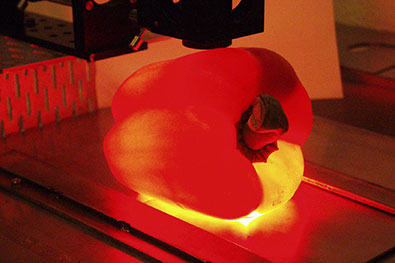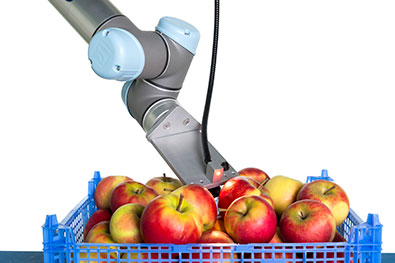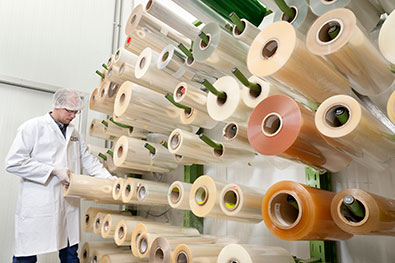
Research facility for postharvest research and robotics
This facility researches the shelf life of fresh food products and the possibilities for the use of robots in the agri-food sector. In addition, it offers partners the opportunity to attend workshops, classes and meetings or organise their own.
Click and discover the research opportunities at this facility

-

1 Testing room for conditioned transport
The unique ATP testing room tests the performance of flexible and energy-saving forms of refrigerated transport over a temperature range of -20°C to + 50°C . Researchers measure insulation value, cooling capacity and energy consumption, as well as qualification measurements that are used to give guarantees on the progression and distribution of temperature in the cargo
-

2 Plaza: demonstration and training room
The Plaza is an inspirational space where a broad range of results and prototypes from various research projects are presented. Partners of Wageningen Food & Biobased Research have the opportunity to make use of this facility themselves. It can be used, for example, to inform their network in a unique location about the latest developments in the area of post-harvest research and robots in the agrifood sector. Training courses, workshops, presentations and demonstrations are given during the year. Please get in touch with us for more information.
-

3 Vision room
Advanced measurement modules for determining the quality of fresh products are developed in the vision room. Various optical and 3D sensors measure both the external and internal aspects of the product. Hyperspectral cameras precisely measure the absorption spectra in the visual and near-infrared spectrum, for instance, while the Marvin TM ensures an ultra-quick 3D reconstruction of the product. Advanced data analysis techniques then convert the raw data into quality aspects. Methods are developed by means of Deep Learning to have this transition take place automatically. This contributes towards the flexibility of automatic measurement systems, so that we can deal with various products and quality aspects.
-

4 Robotics room
The robotics room houses various robots that can be used to research the extent to which the quality and efficiency of agrifood processes can be improved by automation. One robot, for example, can bring various sensors, such as an NIR measuring head and a gas probe, close to food products to precisely determine the quality. There is also the PicknPack robot, which can place food from harvest crates into consumer packaging. This facilitates the automation of fresh product packing.
-

5 CA rooms (controlled atmosphere)
These rooms contain 150 airtight cylinders that can be used to research controlled atmosphere, ultra-low oxygen and dynamic controlled storage of fresh products on a research scale. This proven combination of technical knowledge and product-specific expertise has led to new insights and applications of CA technology, such as the non-chemical control of pest organisms (CATT).
-

6 Recycling room
Research into the recycled products and waste flows that packaging materials end up in is carried out in the recycling room. This ensures a scientifically-substantiated understanding of recycling chains, the choice of a collection system and the effects of developing and improving sorting and reprocessing technologies.
-

7 Cold rooms
The facility has several cold rooms in which temperature and humidity can be determined for each required research situation. This enables researchers to imitate the situation of each link of the chain in order to develop new storage systems and technologies for keeping the quality level of fresh products as high as possible.
-

8 Flowering rooms
Three flowering rooms for flowers simulate living room conditions to carry out research into what is known as the ‘vase life’ of flowers and plants. Vase life refers to the period of time that flowers/plants stay fresh after harvesting, transport and distribution. These rooms provide researchers the opportunity to monitor the development of the flowers/plants on a 24/7 basis.
-

9 CA rooms (controlled atmosphere)
The facility has 40 climate-controlled rooms in which temperature and humidity can be determined for each required research situation. This enables researchers to develop new storage systems and technologies for keeping the quality level of fresh products as high as possible. One of these rooms is dedicated to Controlled Atmosphere Temperature Treatment (CATT). This is a heat treatment that is combined with a modified air composition to further develop the non-chemical control of pest organisms. This is also applied as a quarantine treatment for the import and export of fresh products.
-

10 Gas diffusion room
The physical properties of packaging materials are measured in the gas diffusion room. Different gas chromatographies are set up for measuring the production of ethanol/methanol, ethylene, oxygen and carbon dioxide by the various fresh products that are stored in the 150 CA cylinders (controlled atmosphere).
-

11 Physiology room
This is the Quality Phenomics room where both the internal and external phenotypes of a product are measured in what is known as a ‘measuring train’. All the non-destructive measurements are performed first, followed by the external destructive measurements and the internal measurements. This provides insight into colour, weight, sturdiness, damage, spots, internal colour, internal variations, sugar content and acidity, dry matter determination, etc. These details are used to precisely assess the current and anticipated quality of fresh products.
-

12 Cold rooms
The facility has several cold rooms in which temperature and humidity can be determined for each required research situation. This enables researchers to imitate the situation of each link of the chain in order to develop new storage systems and technologies for keeping the quality level of fresh products as high as possible.
-

13 Packaging room
There is a wide range of packaging material available in the packaging room that can be used to research which type of packaging material ensures that a fresh product (or meal) stays fresh as long as possible. The best convenience products can be produced with the help of applications such as packing under controlled atmosphere, hot fill and mild processing.
-

14 Mobile research facility
The mobile research facility, which belongs to the ‘COOL – Research on the move’ concept, will contribute towards post-harvest technology research projects in developing countries. The research container already aims to drastically reduce the time frame for turning a good idea into a concrete and practical solution that really ensures food has a longer shelf life, thus resulting in less food waste. This affords businesses and governments the opportunity to carry out their own research under the guidance of Wageningen’s researchers.